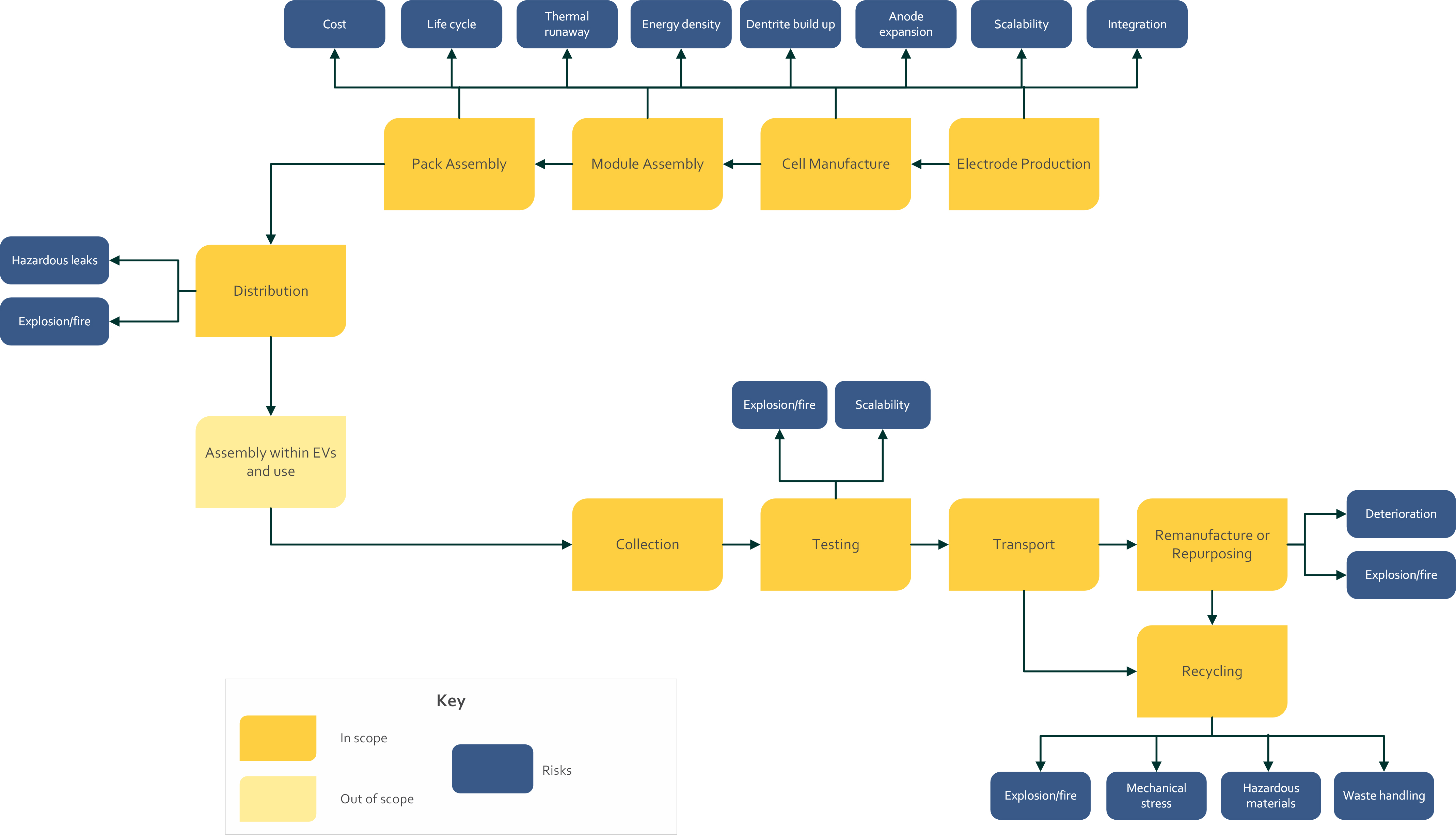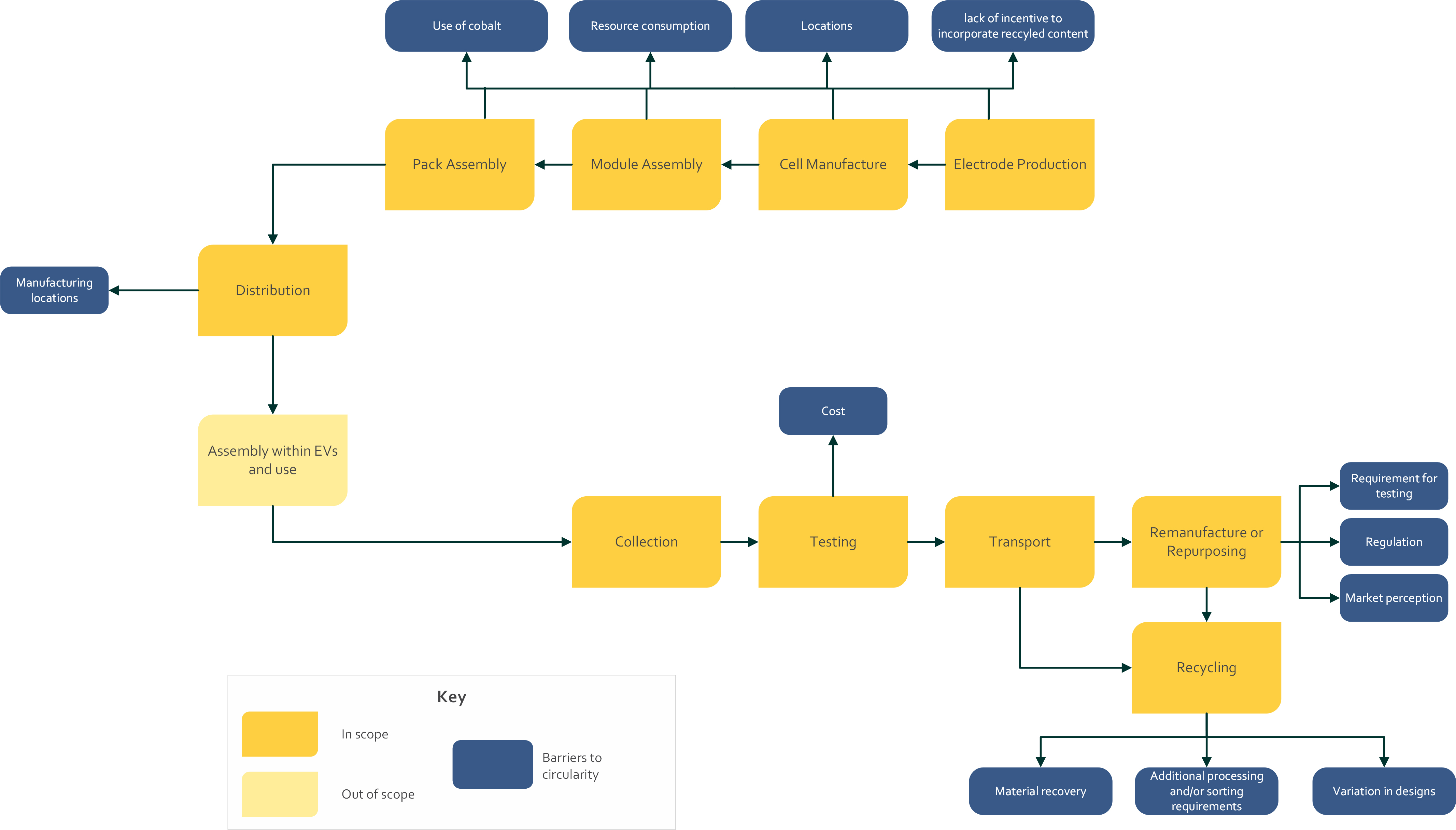10.0 Conclusions
EVs are the fastest growing segment in the mobility sector. They are considered an integral component of the overall approach to reducing emissions from transport and are consequently experiencing considerable growth in demand.
The EV battery value chain is complex. The numerous stages of extraction, production and assembly span multiple actors across a range of different countries (and indeed continents). Despite this, activity related to EV battery manufacture within the Nordics is increasing, and innovators are establishing new sites that target one or multiple stages of production or end-of-life management.
Most of the stages of EV battery manufacture are subject to the Industrial Emissions Directive and operators are therefore required to obtain and comply with permits that set conditions for their operation. These detail the permitting conditions (including the emissions limit values) that are ideally based on industry-specific Best Available Techniques (BATs), as detailed in BAT Reference Documents (BREFs). As the EV battery value chain is experiencing rapid growth and evolution at all stages, specific BATs and BREFs do not yet exist. Consequently, the aims of this study were to:
- Understand the range of technologies available to contribute towards the EV battery manufacturing value chain;
- Identify the risks associated with each of these technologies;
- Highlight the potential emissions understood to result from the operation of these processes; and
- Determine barriers to further circularity in each of these value chain stages.
A summary of the risks, emissions and barriers to further circularity are included in Table 10‑1.
Table 10‑1: Summary of value chain stages and associated risks, emissions, and barriers to circularity
Stage | Risks | Emissions | Barriers to Circularity |
|---|---|---|---|
Manufacture | Cost – depending on the design, material and production costs can vary significantly. They can also vary due to supply chain fluctuations. Life cycle – some chemistries have shorter life cycles than others. Thermal runaway – some chemistries are more susceptible to thermal runaway than others. Energy density – some battery chemistries have lower energy densities than others. Thus, these may need to be larger and heavier to achieve the same storage capacity. Dendrite build up – some chemistries are susceptible to the build-up of dendrites, which can result in short-circuiting. Anode expansion – certain battery designs (e.g., silicon-graphite) expand during use. This can cause design issues. Scalability – as new designs and processes emerge, effective scaling can be challenging. Integration – combining technologies during manufacture can cause issues. | GHG emissions – the production of batteries can lead to substantial greenhouse gas emissions. Heavy metals – some chemistries use large quantities of heavy metals (e.g., cobalt, nickel), which pose risks to the environment and to human health. VOCs – battery production can result in the release of VOCs (e.g., hydrogen fluoride), which are harmful to humans if subject to exposure over extended periods. Contaminated wastewater – the solvents used during the manufacture of some battery chemistries can result in significant volumes of contaminated wastewater. | Use of cobalt – cobalt is a rare and toxic metal that is an essential component of many current battery designs. Recycling processes are not yet optimised to recover cobalt from end-of-life batteries. Resource consumption – the reduced energy density of some chemistries results in the need for larger batteries that require more material to achieve the same storage capacity. Locations – manufacturing capacity for some chemistries is limited primarily to China. Consequently, the ability to create a circular supply chain in the Nordics is limited. Lack of incentive to incorporate recycled content – recycling batteries can be costly, so recycled content is typically expensive. Without targeted incentives to incorporate recycled content, few manufacturers deviate from virgin materials. |
Distribution, collection, transport | Hazardous leaks – transportation of batteries risks incidents that could result in leaks of hazardous chemical and heavy metals that could contaminate soil and water. Explosion/fire – if not properly discharged, end-of-life batteries can lead to fire risks. This risk is exacerbated when large volumes of batteries are stored or transported together. | GHG emissions – the battery value chain is currently international. Consequently, there are CO2 and other greenhouse gas emissions associated with transport of parts and materials between sites. | Manufacturing locations – manufacturing capacity for some chemistries is limited primarily to China. Consequently, the ability to create a circular supply chain in the Nordics is limited. |
Testing | Explosion/fire – if not properly discharged, end-of-life batteries can lead to fire risks. This risk is exacerbated when large volumes of batteries are stored or transported together. Scalability – as new designs and processes continually emerge, effective scaling can be challenging. | Current testing processes are largely non-destructive with no significant emissions. | Cost – current testing processes are often specific to certain battery designs. Therefore, the lack of scalability renders them expensive, creating a barrier to greater circularity. |
Repurposing | Deterioration – unexpected or unidentified deterioration of batteries can render them unusable (and unsafe) in secondary applications. Explosion/fire – any process associated with battery handling carries a risk of explosion and/or fire. | No known significant emissions. | Requirement for testing – end-of-life batteries must first undergo rigorous testing before being deemed fit for repurposing. Regulation – a lack of clear policy related to battery repurposing limits the reuse market. Market perception – consumer acceptance of second life batteries is highly varied. |
Recycling | Explosion/fire – if not properly discharged before recycling (namely shredding), end-of-life batteries are at risk of explosion or fire. Mechanical stress – the high temperatures needed for some recycling processes can cause mechanical stress on machinery. Hazardous materials – waste byproducts of recycling processes can be hazardous. Waste handling – contaminated water and other byproducts can present a risk to human and environmental health. | Dust and particulates – many recycling processes cause dust and particulates, which can be hazardous. Abatement systems are often used, but these often use water. Wastewater – water produced during the abatement of dust and particulates can be considered hazardous. Toxic gases – many recycling techniques can result in the generation of toxic gases (e.g., halogens). Noise and vibration – mechanical recycling processes can produce noise and vibrations. GHG emissions – processes requiring high energy consumption can lead to substantial greenhouse gas emissions. Slags/slurries – recycling processes can produce residual slags/slurries that may be hazardous and can contaminate soils and groundwater. | Material recovery – recycling processes are typically designed to recover a certain material fraction. Some battery recycling processes can leave lower value materials (e.g., plastics) unrecovered. Additional processing and/or sorting requirements – some of the outputs of battery recycling processes require further processing and/or sorting before they are suitable for secondary use. This can increase overall cost. Variation in designs – batteries have not historically been designed with recycling in mind. This may limit the suitability of the available processes. |

Figure 10‑1: Overview of key risks within the battery value chain

Figure 10‑2: Overview of key barriers to circularity within the battery value chain